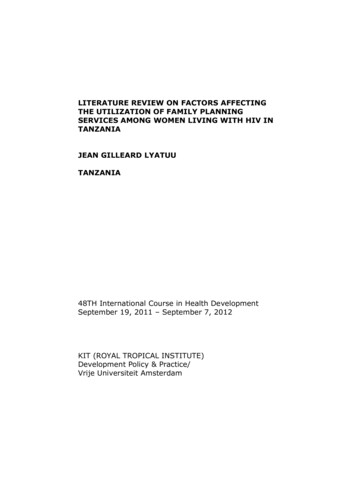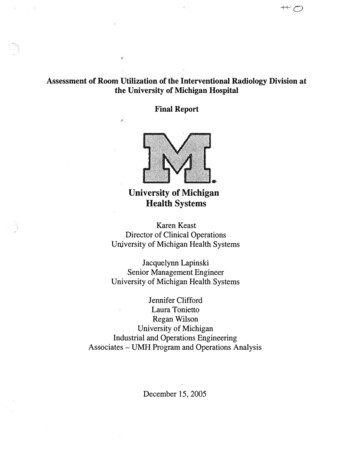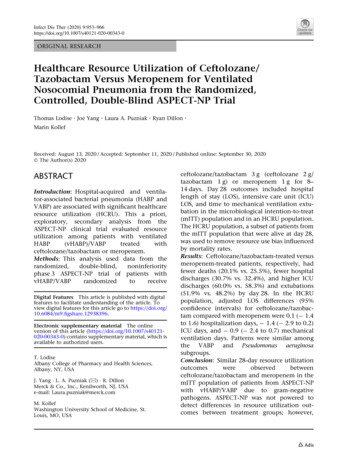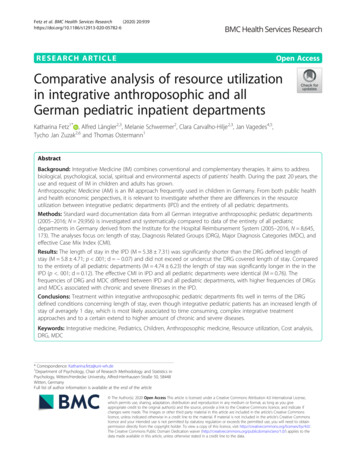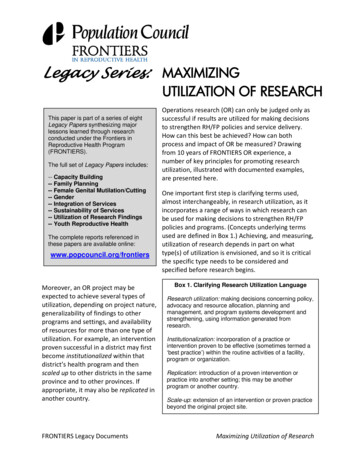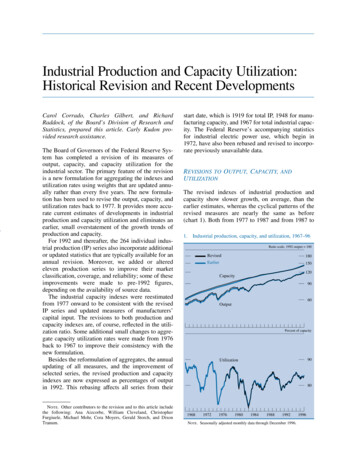
Transcription
FAO IndonesiaPROMOTING SAGO STARCH UTILIZATION IN INDONESIASe pte m b e r 2019SDGs:Countries:IndonesiaProject Codes:TCP/INS/3503 (Phase I) and TCP/INS/3701 (Phase II)FAO Contribution:USD 339 000Duration:2 November 2015 – 31 March 2019Contact Info:FAO Representation in IndonesiaFAO-ID@fao.org
TCP/INS/3503 - 3701PROMOTING SAGO STARCH UTILIZATION IN INDONESIAImplementing PartnerIMPACTMinistry of Agriculture (MoA).The projects contributed to food diversification and foodsecurity in Indonesia by building capacity to produce,utilize and market sago starch and its downstreamprocessed products as alternative carbohydrate sources.At the end of the projects, the food security of farmersand women farmer groups at the target sites wasimproved through increased physical access to sagostarch, as well as through improved economic accessresulting from increased market opportunities realizedthrough value addition.BeneficiariesNational Agency for Food Security.Country Programming FrameworkCPF Priority 2: Reduce rural poverty, improve inclusivefood system and enhance value chain development.ACHIEVEMENT OF RESULTS FAO IndonesiaBACKGROUNDIt is estimated that by 2025 Indonesia will have apopulation of 300 million people and will requireapproximately 18 million tonnes of rice to feed itspopulation. The increasing trend in rice consumption dueto population growth rate in Indonesia in recent years,however, has raised concerns for the country’s foodsecurity. Sago starch consumption in Indonesia offers asignificant opportunity to contribute to the elimination offood insecurity. Promoting awareness of sustainable sagopalm production and starch extraction is the key toincreasing sago starch utilization. Adding value to sagostarch through downstream processing and linking thevalue added products to markets are also critical to thesustained growth of sago production. To address thesechallenges, the projects aimed to raise awareness andpromote advocacy for the sustainable production andutilization of sago starch, strengthen the application ofgood agricultural practices (GAP) in sago palm productionand promote good manufacturing practices (GMP) in sagostarch production. The projects would also buildcapacities to promote the creation of small food-basedsago starch enterprises by piloting integrated units forsago starch extraction and wastewater and hampasmanagement and utilization in South Konawe andKonawe District, and Kendari City, South East Province.The project outcome of improved food security of farmersand women farmer groups at the target sites wassuccessfully achieved. The outputs delivered included theorganization of an inception workshop and two terminalworkshops, and the conduct of a Sago Festival for around450 participants. The hygienic processing of sago andits products was promoted in four high schools in Kendarifor 200 students, and a media campaign on local radioand television was launched to promote sago starchutilization. Awareness-raising material on the potentialof sago palm, for use by extension staff, farmers andcommunities, was developed, and a socialization forumwas held for three extension staff members and52 farmers to introduce the potential of sago palm.Training in good sago field management practices wasprovided for 42 farmers and demonstration plots wereestablished in Konawe District and South Konawe District.Two sago starch processing units (SSPUs) wereestablished and guidelines for SSPU enterprises weredeveloped and disseminated. Thirty farmers were trainedin the application of GMP in the two SSPUs. Finally, amarket survey was conducted to collect ideas ondeveloping sago-based products, on the basis of which25 women were trained in GMP for the production ofsago-based products and the development of businessproposals. FAO Indonesia1
TCP/INS/3503 - 3701PROMOTING SAGO STARCH UTILIZATION IN INDONESIAIMPLEMENTATION OF WORK PLANPhase I (TCP/INS/3503) was scheduled to end inDecember 2017 and most project activities had beenimplemented in line with the work plan by that date.However, completion of the SSPU was delayed byconstraints regarding material procurement, social issuesamong beneficiaries and bad weather. This affected SSPUoperations and the implementation of the agri-businessplan, and had a negative impact on building farmers’capacity with regard to entrepreneurial and businessskills. Phase II (TCP/INS/3701) thus focused on providingsupport to the development of the managerial andentrepreneurship skills of the three viable businessunits developed under Phase I in Kendari, KonaweDistrict, and South Konawe.FOLLOW-UP FOR GOVERNMENT ATTENTIONIt is recommended that the Government follow upimplementation of GAP and GMP, and that trainingcontinue to be given in sago starch processing and relatedbusiness activities. Regular promotion of the benefits ofsago-based staple foods by local and nationalgovernments is also required.Regular monitoring by extension workers to maintainGMP at farmer level is recommended. Extension workersshould also be regularly supervised to ensure continuedgood practices.The Government should continue to endorse thepromotion of viable business units run by farmer groups.Partnerships and alliances should be created orstrengthened to contribute to project sustainability withstrong facilitation and support by the government.Collaboration was sought with a non-governmentalorganization (NGO), Gerakan Desa Emas, to ensure suchsustainability.SUSTAINABILITY1. Capacity development3. Environmental sustainabilityThe project mainstreamed environmental sustainability inactivities regarding attitude, facilities and capacity buildingwith regard to waste management in SSPUs.4. Human Rights-based Approach (HRBA) – in particularRight to Food and Decent WorkAlthough the project did not directly contribute to theimprovement of labour conditions in rural areas, itimproved local H male and female farmer groups’knowledge of more sustainable sago production andprocessing.5. Technological sustainabilityThe technology and managerial skills introduced by theproject in the form of SSPUs can be modified and scaledup. MoA is currently replicating the successes achievedunder the project by constructing SSPUs at ten sites infour new provinces.The project contributed to the development of localknowledge on sustainable sago production through thedevelopment of SSPUs in Konawe and South Konawe.Several women’s group were trained in the use of sagostarch to produce value added products.Stakeholders and beneficiaries were trained to implementGAP in sago production and GMP in the production andutilization of sago starch, and of sago-based products, atthree sites. Participants were keen to apply the skillsacquired. Monitoring, evaluation, supervision must becontinued on a periodic basis after the handover of theprogramme to ensure that beneficiaries are able tosustainably manage viable business units.6. Economic sustainabilityThe project supported the beneficiary farmers toimplement GAP and GMP. The SSPU model is affordablefor national and local government as well as for farmers’associations or cooperatives, as the model has beendesigned to be scalable.The Government has stated that the SSPU model will bereplicated in four more provinces to optimize theopportunities for turning sago palm cultivation andprocessing into a viable rural industry.2. Gender equalityMore men than women participated in sago fieldmanagement and SSPU activities because of the physicaldemands made by the activities. Women were, however,involved in the production of sago-based products. Atfield level, although more men than women participatedin training, this reflected the membership of local farmergroups and did not indicate a lack of attention to genderequality. FAO Indonesia2
TCP/INS/3503 - 3701PROMOTING SAGO STARCH UTILIZATION IN INDONESIADOCUMENTS AND OUTREACH PRODUCTS Back-to-office report (BTOR) of National Consultant(NC) on Agronomy, First Mission (2 May-31 July 2016).Yulius Barra Pasolon. Jakarta. 2016. 22 pp. Technical Guidelines for Local Training: Agronomicand GAP of Sago Palm (5-8 September 2016).Yulius Barra Pasolon. Jakarta. 2016. 4 pp. Progress Report of NC on Agro-processing(7 October 2016). Prayoga Suryadarma. Jakarta. 2016.7 pp. BTOR of NC on Agro-processing(4-13 December 2016). Prayoga Suryadarma. Jakarta.2016. 4 pp. FAO Indonesia Technical Guidelines for Local Training: Agronomicand GAP of Sago Palm. FAO. Kendari. 2016. 5 pp. BTOR of NC on Agro-processing (19-22 April 2017).Prayoga Suryadarma. Jakarta. 2017. 4 pp. BTOR of NC on Agro-processing (22-27 May 2017).Prayoga Suryadarma. Jakarta. 2017. 4 pp. BTOR of NC on Marketing (5-18 June 2017).Mohamad Reyza Ramadhan. Jakarta. 2017. 13 pp. BTOR of NC on Agro-processing (15-22 July 2017).Prayoga Suryadarma. Jakarta. 2017. 4 pp. FAO Indonesia BTOR of NC on Agro-processing (3-18 August 2017).Prayoga Suryadarma. Jakarta. 2017. 9 pp. BTOR of NC on Communication(10-17 September 2017). M. Aswan Zanynu. Jakarta.2017. 4 pp. BTOR of NC on Agro-processing (2-4 October 2017).Prayoga Suryadarma. Jakarta. 2017. 9 pp. BTOR of NC on Marketing (10-12 October 2017).Mohamad Reyza Ramadhan. Jakarta. 2017. 3 pp. BTOR of NC on Communication(28 October-13 November 2017). M. Aswan Zanynu.Jakarta. 2017. 6 pp. FAO Indonesia BTOR of NC on Marketing (15-20 November 2017).Mohamad Reyza Ramadhan. Jakarta. 2017. 6 pp. BTOR of NC on Communication(15-19 December 2017). M. Aswan Zanynu. Jakarta.2017. 5 pp. End-of-assignment Report of NC on Communication.M. Aswan Zanynu. Jakarta. 2017. 21 pp. Guidelines for Waste Management. FAO. Kendari.2017. 4 pp. BTOR of NC on Marketing (5-7 February 2018).Mohamad Reyza Ramadhan. Jakarta. 2018. 3 pp. Photographs. Various. FAO Indonesia Video. Various.3
TCP/INS/3503 - 3701PROMOTING SAGO STARCH UTILIZATION IN INDONESIAACHIEVEMENT OF RESULTS - LOGICAL FRAMEWORKExpectedImpactOutcomeFood diversification and food security in Sulawesi island of Indonesia are improved as a result ofimproved production, utilization and marketing of sago starch and its downstream processed productsas alternative carbohydrate sourcesImproved food security of farmers and women farmer groups at the target sites through increasedphysical access to sago starch as an alternative carbohydrate source, as well as through improvedeconomic access resulting from increased market opportunities realized through value additionImproved community capacity in production, utilization and marketing of sago starchIndicatorand its downstream processed products as alternative carbohydrate sources.Lack of awareness and attention of local government, extension agents and societyon potential of production and processing of sago palm.Limited involvement of district and local government officers in promoting sago starchproduction and utilization.Lack of sound guidelines for sago field management.Limited capacity of extension agents and farmers to implement GAP in sago production.Lack of pilot demonstration plots for sago starch extraction, waste management andBaselineeffluent utilization.Inadequate human resource capacity to support efficient manufacture of sago starch.Lack of capacity of farmer and women groups in sago processing, packaging andmarketing.Inadequate capacities of farmers, particularly women farmers, to access financial supportfrom banks or local governments for sago starch production.Lack of entrepreneurial skill and limited capacity in enterprise development.Lack of information on market development system and trade.Two demonstration plots established to promote improved sago field management.Two SSPUs established in sago-producing areas.End TargetWell trained extension agents, farmer groups and women’s groups in sago starchprocessing.CommentsMonitoring and evaluation is required in order to follow up implementation of GAPand follow-upin sago gardens and GMP in SSPUs, producing high quality sago-based products,action to beand ensuring sustainability in managing viable business units.takenAwareness raised and advocacy promoted on potential of sago palm and its contribution to farmingand local community livelihoods, as well as to food diversification and food securityOutput 1BaselineCommentsActivity 1.1IndicatorsTargetAchievedInception and terminal workshopsuccessfully implemented.Number of promotional activities on sagostarch utilization implemented for differenttarget groups.One inception workshop and two terminalworkshops held: (one at end of Phase 1and one at end of Phase 2).At least four promotional activitiesimplemented with stakeholders to promotesago starch utilization among end consumersin Kendari city.Yes0There were no impediments to implementation. A high level of interest was stimulated in upgrading sagoproduction and processing. Continued promotion of the benefits of sago-based staple foods by local andnational governments is required.Project inception workshop implementedAchievedYes52 stakeholders, including Lead Technical Officer, FAO and government representatives,and academia, participated. Terminal workshops were also conducted at the end of bothCommentsproject phases. At the end of Phase I, the terminal workshop was attended by60 government, academia, NGO and farmer representatives. The second terminalworkshop was attended by 14 participants from the Government and FAO.4
TCP/INS/3503 - 3701PROMOTING SAGO STARCH UTILIZATION IN INDONESIAActivity 1.2Activity 1.3Activity 1.4Awareness raised for extension staff and farmers, as well as communities, on potential of sago palmthrough appropriate communication mediaAchievedYesAwareness was raised through the conduct of a Sago Festival, targeted to attract interestand attention of youth in particular, in sago processing and packaging. Approximately450 individuals participated.Hygienic processing of sago and its products was promoted in four high schoolsin Kendari with the participation of 200 students.A media campaign on local radio and local television was launched to promote sagoCommentsstarch utilizationSix joint field visits were held in Konawe, South Konawe and Kendari.Three extension staff members and 52 farmers participated in a socialization forumto introduce the potential of sago palm.Training of extension workers in sago starch processing and related business should becontinued.Development and distribution of educational materials to promote awareness on sago palm in schoolsAchievedYesAwareness-raising material on potential of sago palm, targeted for use by extension staff,farmers and communities was developed.CommentsPromotional materials were distributed to four high schools in Kendari.Regular promotion programmes are required for the development, improvement andpromotion of sago consumption.Promotion of sago starch utilization and its value addition involving local government (province, district,and sub-district), banking, and local and national sago starch-related entrepreneurs or companiesAchievedYesThe participation of government representatives, micro and small entrepreneursand particularly youth in the Sago Festival held in Kendari promoted greater awarenessand interest in the potential for value addition to sago.The potential of sago was promoted on local television and radio to reach a broadCommentsaudience across Kendari City.Billboards were posted in three strategic locations for a period of three monthsto promote awareness and interest.Continued support is needed to maintain the trend of increasing sago consumption.At least 20 farmer groups benefit from an improved technical knowledge base on the application of GAPin sago palm productionIndicatorsOutput 2BaselineCommentsActivity 2.1TargetAchievedNumber of sound guidelines for sagoAdaptable guidelines for farmers and extensionfield management.workers on implementing GAP of sago fieldNumber of pilot demonstration plotsmanagement developed for at least 20 farmerYesestablished.groups.Number of farmer groups trained.Sago field demonstration plot developed.0There were no impediments.Regular monitoring by extension workers is recommended. This support will maintain practices at farmerlevel. The success stories of farmer groups that have benefited from the programme will thus influenceother farmer groups.Farmer training - theoretical and practical - on the application of good sago field management practices(nursery, thinning, treatment, pre and post-harvest) using appropriate extension mediaAchievedYesForty-two farmers were trained in application of good sago field management practices(nursery, thinning, treatment, pre and post-harvest) using appropriate extension media.One demonstration plot was established in Labela Village in Konawe District and anotherCommentsin Kosebo Village in South Konawe District.Forty-two farmers benefited from access to equipment and tools for sago fieldmanagement activities.Regular supervision will be required to assure sustainability of the intervention.5
TCP/INS/3503 - 3701PROMOTING SAGO STARCH UTILIZATION IN INDONESIAAt least 20 farmer groups benefit from capacity building designed to improve GMP for starch extractionIndicatorsTargetAchievedNumber of farmers trained in GMP.Equipment and tools for sago starchextraction, wastewater and solid wastemanagement and utilization providedto farmer groups.An integrated unit for sago starch extraction,wastewater and solid waste managementand utilization established with farmergroups.At least 20 farmer groups trained to managethe processing units in Konawe and SouthKonawe.YesOutput 3BaselineCommentsActivity 3.1Activity 3.2Activity 3.30There were no impediments. Regular monitoring and supervision by extension workers are suggestedto maintain the practices at farmer level. The success stories of farmer groups that have benefited fromthe programme will thus influence other farmer groups.Establishment of a pilot demonstration integrated unit for sago starch extraction, wastewater and solidwaste management and utilization with farmer groupsAchievedYesTwo SSPUs were established with the implementation of GMP.The SSPUs were managed by six selected and trained farmers and operated by nine otherfarmers. In South Konawe, the SSPU was managed by five selected and trained farmersCommentsand operated by nine other farmers.Extension workers must be regularly supervised in order to ensure continued goodpractices as this is still a new approach for the farmers.Improvement of farmer knowledge and skills on implementation of GMP in post-harvest handling chainfor sago palm, and in sago starch extraction from pithAchievedYesGuidelines for SSPU enterprises including sago starch production and utilization, andsago waste treatment and utilization were developed and disseminated.CommentsThirty farmers were trained in application of GMP on SSPU in Konawe and South Konawe.Regular supervisory activity needs to be applied by extension workers as this is still a newapproach for farmers.Establishment of an initial farmer group economic unit or cooperative, specialized in sago starchproduction and utilizationAchievedYesSSPUs were operated by two working groups, specialized in sago starch productionand utilization and implementing GMP in their operations.CommentsRegular supervisory activity needs to be applied by extension worker as this is still a newapproach for the farmers, as well as regular business evaluation to ensure mutual benefitamong all groups involved.6
TCP/INS/3503 - 3701PROMOTING SAGO STARCH UTILIZATION IN INDONESIAAt least 25 entrepreneurs benefit from technical and agri-business training designed to promote sagostarch enterprise developmentIndicatorsOutput 4BaselineCommentsActivity 4.1Activity 4.2Activity 4.3Activity 4.4Activity 4.5TargetAchievedNumber of farmer and women groups withcapacity built in sago processing, packagingThe current marketing situation for sagoand marketing.starch and sago flour in Indonesia criticallyNumber of farmers equipped withappraised.Yesentrepreneurial skills and enterpriseBusiness groups that sustainably producedevelopment.sago-based products of good qualityLevel of available market information forestablished.sago.0There were no impediments.Regular supervisory activity needs to be applied by extension worker as this is still a new approach forthe farmers. Continuing endorsement by the Government to promote viable business districts run bythe farmer groups is required.Conduct of a market survey to assess consumer and market interest in a range of sago-starch-basedproducts.AchievedYesTwelve food and beverage practitioners and ten food writers were involved in a marketCommentssurvey to collect ideas on developing sago-based products that fit with market trendsfor feedback to processed sago-based food producers.Training of women’s groups in the efficient processing, packaging and marketing of sago starch-basedfood products with good market potential and that contribute to food diversification and food securityAchievedYesTwenty-five women from three women’s groups were trained in GMP for production ofsago-based products (healthy crackers (kerupuk), macaroni, improved traditional cake(bagea), and sago cake and benefited from increased income.CommentsThe Mata sub-district in Kendari city has diversified its product base, improved itshygienic management and expanded its market access.Continuous endorsement by the Government to promote viable business districts runby the farmer groups is required.Training of farmer groups and women farmers on the preparation of bankable business plan proposalsAchievedYesTwenty-five women from three women’s groups were trained in the developmentof business proposals.CommentsFurther monitoring and technical assistance on business calculations, financialforecasting, and setting up business targets are still required to ensure properand sustainable implementation of the business plan.Dissemination of successful experiences of sago starch-based agri-business and provision of supportfor supporting exchange visits to individual farmers and women champions (groups)AchievedYesCommentsNoneDevelopment of and support to the creation and strengthening of producer and market organizations forsago starch and its downstream productsAchievedYesCollaboration was established among business actors of the three target sites to supportthe value chain. The project helped to set up three working groups, in Kendari City,Konawe District, and South Konawe. The groups were trained in collectiveentrepreneurship, marketing, finance and administration. The districts were inclusivelyconnected and engaged in processing of the pith into sago flour, followed by valueaddition in the production of sago-based products. The inclusive group was called SaguCommentsMeambo Food and managed by 13 farmers.Further close monitoring must be focused on strengthening capacity of the businessenterprises established during Phase I to ensure that they function fully, above all withregard to: the collaboration mechanism among three main actors; transactionsmanagement; marketing plans; and business meetings and profitable negotiationto ensure business sustainability.7
Outreach, Marketing and Reporting Unit (PSRR)Business Development and Resource Mobilization Division (PSR)For more information please contact: Reporting@fao.org
effluent utilization. Inadequate human resource capacity to support efficient manufacture of sago starch. Lack of capacity of farmer and women groups in sago processing, packaging and marketing. Inadequate capacities of farmers, particularly women farmers, to access financial support from banks or local governments for sago starch production.


